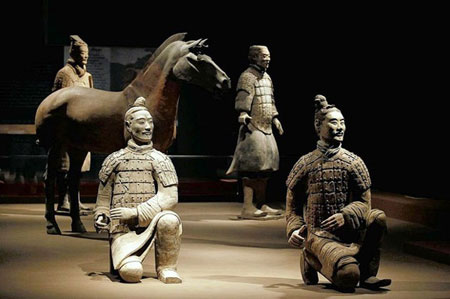
Continuing through March 4, 2012
The stars of “Warriors, Tombs and Temples: China’s Enduring Legacy” are four life-size Terra Cotta Warriors, newly conserved with clear paint on their faces, set on a stage at the entrance to the exhibition galleries. These recall this museum’s monumental 2008 show of dozens of these figures, unearthed from the 2,300-year-old Chinese tombs of Qin Shi Huang, the first Emperor of China. This is a broader, more magnanimous exhibition, with many relics shown here for the first time outside of China. Included are artifacts from tombs of the Qin, Han and Tang dynasties, 221 BCE to 907 CE. In this period, China experienced unification, military might, territorial expansion (due largely to success of the Silk Road), extensive building and achievements in the arts, crafts and technology. Less dramatic, but equally impressive are the smaller (1/3 original size) terra cotta warriors from the imperial tomb of the Han dynasty (206 BCE to 220 CE). These also have naturalistic features but exhibit more peaceful facial expressions than their earlier counterparts. Male and female attendants, animals, including a dog, horse and pig, as well as eating and drinking utensils (necessary for a comfortable afterlife) hint at the range of objects stored away with the royal remains. There is also a set of ornate stone tomb doors. From the more prosperous Tang Dynasty (618 to 907 CE), there are gold dragons, ornaments, a tomb guardian, a painting of a polo game between royals and precious stone and metal reliquary boxes. With the now widespread interest in ancient Chinese relics, this exhibition stands out, not only for the objects on display, but for the theatrically lit installation and clean, easy to view displays.
Published courtesy of ArtSceneCal ©2011
